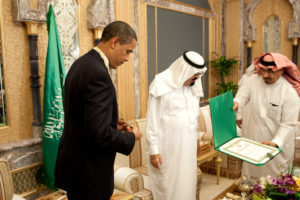
President Barack Obama and Saudi King Abdullah bin Abdul Aziz in Riyadh, Saudi Arabia, June 3, 2009. (Official White House photo by Pete Souza)
In The American Conservative, Daniel Lazare explains the complicated relationship between the United States and Saudi Arabia and how that relationship has worked to foster the expansion of radical Islam across the Muslim world. He writes:
Chatting with Australian Prime Minister Malcolm Turnbull at the Asia-Pacific Economic Cooperation summit in November 2016, Barack Obama mentioned Indonesia, where he spent part of his childhood back in the 1960s. The country, he noted, was a changed place. Where Muslims once adopted elements of Hinduism, Buddhism, and animism, a more austere version of Islam had taken hold once Saudi Arabia began pouring money into Wahhabist madrassas in the 1990s. Where women had formerly gone about with their heads uncovered, the hijab began to spread.
But why, Turnbull wanted to know, was this happening? “Aren’t the Saudis your friends?” To which Obama replied, “It’s complicated.”
That c-word covers a lot of territory, not only with regard to Wahhabism, the ultra-fundamentalist Saudi ideology whose impact is now felt across the globe, but also with regard to the United States, the Saudis’ chief patron, protector—and enabler—since World War II. Like any imperialist power, the United States can be a bit unscrupulous in the partners it chooses. So one might expect it to look the other way when its Saudi friends spread their militant doctrines into Indonesia, the Philippines, the Indian subcontinent, Syria, and numerous points beyond.
But Washington did more than just look away. It actively encouraged such activities by partnering with the Wahhabists in any number of hotspots. They include Afghanistan, where American- and Saudi-armed jihadis drove out the Soviets in the 1980s. They also include Bosnia, where the two countries reportedly teamed up in the mid-1990s to smuggle hundreds of millions of dollars worth of arms into Alija Izetbegović’s Islamic republic, today a stronghold of Wahhabist Salafism. Other notable examples: Kosovo, where the United States joined forces with “Afghan Arabs” and other Saudi-backed jihadis in support of the secessionist movement of Hashim Thaçi; Chechnya, where leading neocons such as Richard Perle, Elliott Abrams, Kenneth Adelman, Midge Decter, Frank Gaffney, Michael Ledeen, and R. James Woolsey championed Saudi-backed Islamist rebels; Libya, where Hillary Clinton personally recruited Qatar to join the effort against Muammar Qaddafi and then said nothing as the Wahhabist kingdom funneled some $400 million to rebel groups, many of them Islamists who proceeded to turn the country upside down; and of course Syria, where Sunni head-choppers backed by the Saudis and other oil monarchies have turned the country into a charnel house.
Read more here.
CNN: Madrassa teaches children to hate U.S.
If you’re willing to fight for Main Street America, click here to sign up for my free weekly email.




